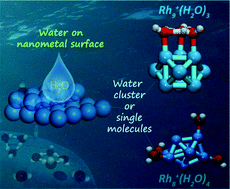Interactions between water and rhodium clusters: molecular adsorption versus cluster adsorption†
Abstract
Understanding metal–water interactions and hydrogen-bonding in water droplets is important but highly challenging. Various transition metals may serve as effective coordination centers to water; however, not in all cases is water bonded to a metal center as single molecules. We report here the observations of gas-phase rhodium clusters and their interactions with water. A series of rhodium–water clusters, Rhn±,0(H2O)m (n = 3–30, m = 1–5), with isotope labels were detected by mass spectrometry after exposure to different water concentrations, among which Rh8+(H2O)4 and Rh9+(H2O)3 were prominent in the mass distributions, showing a size-dependent preference of water adsorption on rhodium clusters. Comprehensive density functional theory calculations reveal that the lowest energy structure of Rh9+(H2O)3 possesses a hydrogen-bonded cyclic (H2O)3 water trimer on the top of a tri-capped Rh9+ trigonal prism. The tri-capped Rh9+ trigonal prism and the cyclic (H2O)3 water trimer match in sizes, charge distributions, and orbital symmetries to form effective electrostatic cluster–cluster interactions. In contrast, Rh8+(H2O)4 contains four water molecules separately attached to a bi-capped octahedron, Rh8+, at four corners via single-molecule adsorption. The difference between covalent molecular adsorption and electrostatic cluster–cluster interaction in these two proto-typical rhodium hydrates is further demonstrated by detailed natural bonding orbital, electrostatic surface potential, and charge decomposition analyses.



 Please wait while we load your content...
Please wait while we load your content...